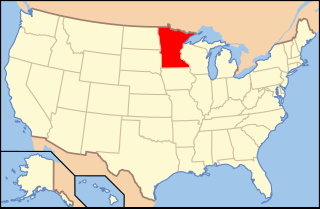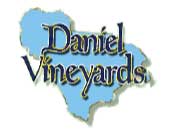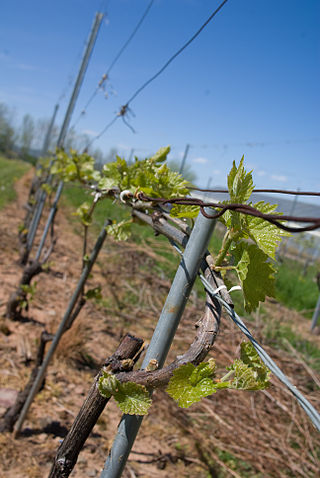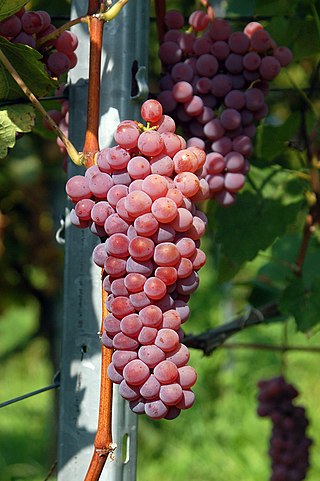Related Research Articles

Aurore is a white complex hybrid grape variety produced by French viticulturist Albert Seibel and used for wine production mostly in the United States and Canada. Over a long lifetime, Seibel produced many complex hybrid crosses of Vitis vinifera to American grapes. The Aurore grape is a cross of Seibel 788 and Seibel 29.

Seyval blanc is a hybrid wine grape variety used to make white wines. Its vines ripen early, are productive and are suited to fairly cool climates. Seyval blanc is grown mainly in England, the United States East Coast, in the Pacific Northwest (Oregon), as well as to a lesser extent in Canada. Seyval blanc was created either by Bertille Seyve, or his son-in-law Villard, as a cross of Seibel 5656 and Rayon d'Or, and was used to create the hybrid grape St. Pepin. Seyve and Villard used the same Rayon d'Or x Seibel 5656 crossing to produce the red wine grape Seyval noir.
La Crosse is a modern hybrid cultivar of wine grape, mostly grown in North America. It produces grapes suitable for making fruity white wines similar to Riesling or as a base for blended wines. The grapes also make a good seeded table grape for eating. It has the benefits of early ripening and when hardened properly in the fall it is winter hardy to at least -25°F. As such it is best suited to growing in more northern climates and can be found grown in small regions of Ohio.

Vidal blanc is a white hybrid grape variety produced from the Vitis vinifera variety Ugni blanc and another hybrid variety, Rayon d'Or. It is a very winter-hardy variety that manages to produce high sugar levels in cold climates with moderate to high acidity.

Vitis rupestris is a species of grape native to the United States that is known by many common names including July, Coon, sand, sugar, beach, bush, currant, ingar, rock, and mountain grape. It is used for breeding several French-American hybrids as well as many root stocks.

Hybrid grapes are grape varieties that are the product of a crossing of two or more Vitis species. This is in contrast to crossings between grape varieties of the same species, typically Vitis vinifera, the European grapevine. Hybrid grapes are also referred to as inter-species crossings or "Modern Varieties." Due to their often excellent tolerance to powdery mildew, other fungal diseases, nematodes, and phylloxera, hybrid varieties have, to some extent, become a renewed focus for European breeding programs. The recently developed varieties are examples of newer hybrid grape varieties for European viticulturalists. Several North American breeding programs, such as those at Cornell and the University of Minnesota, focus exclusively on hybrid grapes, with active and successful programs, having created hundreds if not thousands of new varieties.
Elmer Swenson was an American pioneering grape breeder who introduced a number of new cultivars, effectively revolutionizing grape growing in the Upper Midwest of the United States and other cold and short-seasoned regions.
Onaka is one of a number of hardy hybrid grape cultivars produced by the prolific breeder Nels Hansen at South Dakota State University. It is a product of a cross of Beta and Salem. Although never widely cultivated and today largely forgotten, it has contributed to the cold-climate grape-breeding efforts of breeders such as Elmer Swenson, who suspected a nearby vine of Onaka to be a likely parent of his variety Kay Gray.

Minnesota wine refers to wine made from grapes grown in the U.S. state of Minnesota. Minnesota is part of the largest American Viticultural Area (AVA), the Upper Mississippi River Valley AVA, which includes southwest Wisconsin, southeast Minnesota, northeast Iowa, and northwest Illinois. The state also has a smaller designated American Viticultural Areas, the Alexandria Lakes AVA. Minnesota is a very cold climate for viticulture and many grape varieties require protection from the winter weather by being buried under soil for the season. Minnesota is home to extensive research on cold-hardy French hybrid and other grape varieties.
The Swenson Red is a firm, meaty red table grape with a unique fruity flavor with strawberry notes. This was the first grape released from the breeding efforts of Elmer Swenson, and is a favorite among grape breeders and hobbyists. Though it is known as a red, its actual color changes depending on climate. In cooler areas it will be blue, and in very warm areas it will be a translucent green. This is because many pigments inherited from Vitis vinifera only set during relatively cool weather.
Cascade is a red complex hybrid grape variety that was created by French viticulturist Albert Seibel in the early 20th century in Aubenas, Ardèche, in the Rhône Valley. It has been commercially available in North America since 1938 and has since been planted in Canada and the United States. However, in warmer climates, the grape is highly susceptible to a number of grapevine viruses, which has discouraged plantings of the variety.
Landot noir is a red hybrid grape variety that is a crossing of Landal and Villard blanc. Created after a series of trials between 1929-1949, the grape was introduced to Canada and the United States in the 1950s and today can be found in Quebec as well as New Hampshire where a varietal is produced by Jewell Towne Vineyards.
Ravat blanc is a white hybrid grape variety that is a crossing of Chardonnay and a Seibel grape. While the Vitis International Variety Catalogue (VIVC) maintained by the Geilweilerhof Institute for Grape Breeding lists Seibel 5474 as the second parent, Master of Wine Jancis Robinson notes that other authors list Seibel 8724 as the parent. The grape is often confused with the white hybrid grape Vignoles that is often called just Ravat.
Seyval noir is a red hybrid grape variety that was created in the late 19th century by French horticulturalist Bertille Seyve and his father-in-law Victor Villard from a crossing of two Seibel grapes. The pair used the same two varieties to create the white wine grape Seyval blanc, making the two siblings rather than color mutations of one or the other. The name Seyval comes from a combination of the two men's names.

The Daniel Vineyards is a family-owned estate winery located in Crab Orchard, West Virginia. The vineyard was created in 1990 at the former location of the 192-acre (78 ha) Twin Oaks Golf Course by Doctor C. Richard Daniel, a retired radiologist. About 20 acres (8.1 ha) are used for vineyards, with an additional acreage for blackberries and 3 acres (1.2 ha) for blueberries. Visitors are allowed to pick their own blueberries when in season.

L'Acadie blanc is a white Canadian wine grape variety that is a hybrid crossing of Cascade and Seyve-Villard 14-287. The grape was created in 1953 by grape breeder Ollie A. Bradt in Niagara, Ontario at the Vineland Horticultural Research Station, which is now the Vineland Research and Innovation Centre. Today the grape is widely planted in Nova Scotia with some plantings in Quebec and Ontario. Some wine writers, including those at Appellation America, consider L'Acadie blanc as "Nova Scotia’s equivalent to Chardonnay".
Landal noir is a red hybrid grape variety that was created during a series of trials between 1929 and 1942 by French grape breeder Pierre Landot at his Conzieu nursery in the Ain department of eastern France. The grape is a crossing of two Seibel grapes, Plantet and Seibel 8216. While authorized for use in several French wine growing region, the grape is officially not recommended for use in any quality wine production in France with only 49 hectares of the variety reported in 2008. Outside France, some plantings of Landal noir can be found in Switzerland, Canada and the United States.

Souvignier gris is a white German wine grape variety that was created in 1983 by Dr. Norbert Becker. It is a cross between Seyval blanc and Zähringer, but was originally thought to be a cross between Cabernet Sauvignon and Bronner.
Saint Croix is a wine grape variety developed in 1981 by American grape breeder Elmer Swenson of Osceola, Wisconsin. It goes by the synonyms Saint Croy, E.S. 2-3-21, and Elmer Swenson 242. It is a cross of V. labrusca x V. riparia grapes with cultivar crosses [E.S. 283 x E.S. 193 ].
References
- ↑ Lisa Ann Smiley, Paul Domoto, and Gail Nonnecke, "Cold Climate Cultivars", Iowa State University Dept. of Agriculture, http://viticulture.hort.iastate.edu/cultivars/cultivars.html Archived 2012-06-15 at the Wayback Machine
- ↑ National Grape Registry, http://ngr.ucdavis.edu/
- ↑ Rombough, Lon. The Grape Grower: a Guide to Organic Viticulture. Chelsea Green Publishing, 2002. p. 218. ISBN 1890132829